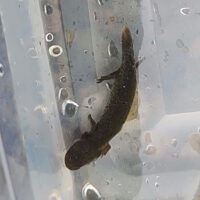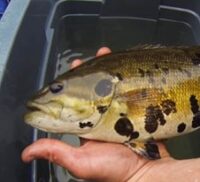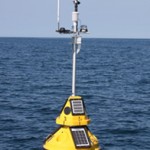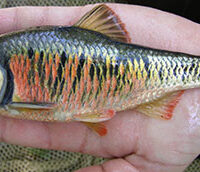 Purdue University - Extension - Forestry and Natural Resources
Purdue University - Extension - Forestry and Natural Resources
Got Nature? Blog
This one-day workshop will focus on aquaponics in the classroom. Topics that will be covered include fish culture basics, plant culture, water quality, systems, and more. 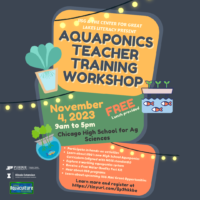
Workshop Participants will:
- Participate in hands-on activities.
- Learn about IISG’s NEW aquaponics curriculum.
- Tour the High School for Ag Sciences aquaponics space.
- Become eligible for a new IISG loan program.
- Hear about IISG programs.
- Be inspired to incorporate aquaponics in the classroom.
Date: Saturday, November 4, 2023
Time: 9 AM – 5 PM Central (CST)
Location: Chicago High School for Agricultural Sciences, 3857 West 111th Street, Chicago, IL, 60655
Program partners include Illinois-Indiana Sea Grant, the Center for Great Lakes Literacy, the Indiana Aquaculture Association, University of Illinois Extension, and Purdue University’s Department of Forestry and Natural Resources.
To learn more about this event and how to register please visit Purdue Extension – Forestry & Natural Resources (FNR) Events.
What is Aquaponics: Fish and Plants Grow Sustainabley Through Aquaponics, IISG Newsroom
About IISG: These are trying times for the environment. Climate change and other concerns such as population growth, aquatic invasive species, contaminated waters, and loss of natural habitat, the southern Lake Michigan region faces many challenges. Illinois-Indiana Sea Grant (IISG), with its unique mandate to bring the latest science to those who can best use the information, serves a critical role in empowering people to solve problems in sustainable ways. The program is funded through National Oceanic and Atmospheric Administration (NOAA), the University of Illinois and Purdue University, but IISG also works in partnerships with key organizations, institutions, and agencies in the region to reach more audiences and multiply opportunities for success. IISG brings together scientists, educators, policy makers, community decision makers, outreach specialists, business leaders, and the general public to work towards a healthy environment and economy.
Resources:
Walleye Farmed Fish Fact Sheet, The Education Store, Purdue Extension’s resource center
Freshwater Prawn Farmed Fish Fact Sheet, The Education Store
Adaptations for Aquatic Amphibians, The Nature of Teaching, Purdue Extension – Forestry and Natural Resources (FNR)
Purdue Extension
Sustainable Aquaculture: What does it mean to you?, The Education Store
A Guide to Small-Scale Fish Processing Using Local Kitchen Facilities, The Education Store
Aquaculture Industry in Indiana Growing, Purdue Today
Purdue Aquaponics: Cut Water Usage, Purdue University YouTube Channel
Largemouth Bass Market Trends, Purdue Extension – FNR YouTube Channel
Amy Shambach, Aquaculture Marketing Outreach Associate
Purdue Department of Forestry and Natural Resources/Illinois-Indiana Sea Grant Program
Andrew Coursey, Aquaculture Specialist
Illinois-Indiana Sea Grant Program
Illinois-Indiana Sea Grant Newsroom: A group of Midwestern shrimp farmers are on a mission to provide Americans with better-tasting, sustainable shrimp. The industry struggled during the COVID-19 pandemic, but farmers remain hopeful that indoor shrimp farming will come back stronger than ever.

Jeff Howell shows off a trio of shrimp at Triple J Farms in Foristell, Missouri. The farm specializes in Pacific Whiteleg shrimp.
Experts say aquaculture, a method used to produce aquatic organisms in controlled conditions, can be a new market for farmers.
Though commercial shrimp farms came to the United States in the 1960s, about 90% of the shrimp Americans eat is still imported, said Amy Shambach, aquaculture marketing outreach associate for Illinois-Indiana Sea Grant.
As consumers start to prioritize sustainability and freshness when shopping for seafood, Shambach said inland shrimp farming can fill the need.
For full article and videos please visit Amy Shambach talks about the future of shrimp farming – IISG
About IISG: These are trying times for the environment. Climate change and other concerns such as population growth, aquatic invasive species, contaminated waters, and loss of natural habitat, the southern Lake Michigan region faces many challenges. Illinois-Indiana Sea Grant (IISG), with its unique mandate to bring the latest science to those who can best use the information, serves a critical role in empowering people to solve problems in sustainable ways. The program is funded through National Oceanic and Atmospheric Administration (NOAA), the University of Illinois and Purdue University, but IISG also works in partnerships with key organizations, institutions, and agencies in the region to reach more audiences and multiply opportunities for success. IISG brings together scientists, educators, policy makers, community decision makers, outreach specialists, business leaders, and the general public to work towards a healthy environment and economy.
Resources
Aquaculture Industry in Indiana Growing, Purdue Today
Farming Shrimp, and Changing the Industry, Far From an Ocean, article available by news service Aljazeera America
Video: Cage Culture and Aquaponics, FNR Youtube channel
Walleye Farmed Fish Fact Sheet: A Guide for Seafood Consumers, The Education Store, Purdue Extension resource center
Sustainable Aquaculture: What does it mean to you?, The Education Store
Fish: Healthy Protein Handout, The Education Store
The Benefits of Seafood Consumption The Education Store
Eat Midwest Fish, Illinois-Indiana Sea Grant online resource hub
Illinois-Indiana Sea Grant (IISG)
MyDNR, Indiana’s Outdoor Newsletter: The Indiana Cooperative Fish and Wildlife Research Unit, or CRU, that Purdue will host, brings together the U.S. Geological Survey, U.S. Fish and Wildlife Service, Purdue University, the DNR, and the Wildlife Management Institute.
Its focus will be on delivering actionable science addressing fish, wildlife, plants, and other natural resources in Indiana and beyond, including the connection between the health of wildlife and the health of people.
The CRU Program is results focused, bringing together natural resource managers and researchers to work as a team to address the most pressing natural resource management needs with science. As such, the partnerships formalized with the creation of CRUs lead to true co-production of research.
“The creation of this new unit is another milestone in the highly successful USGS Cooperative Research Units Program, and we are proud to join the state of Indiana, Purdue University, the USGS, Wildlife Management Institute, and others to address conservation questions facing Indiana and the region,” said U.S. Fish and Wildlife Service Science Applications Program Assistant Regional Director Craig Czarnecki. “We look forward to engaging with the students and professionals at Purdue University as we co-develop scientific research and support the next generation of conservationists.”
But CRUs don’t just tackle management needs. They do so while cultivating the next generation of scientists and resource managers. The new Indiana CRU will focus on education, training, and outreach related to natural resources vital not only to Indiana, but the Midwest and regional economies as well.
Like all CRUs, the Indiana CRU will consist of 2-5 federal scientists along with graduate students, postdoctoral fellows, and administrative specialists. Federal scientists will serve as faculty at Purdue University, teaching graduate-level courses, supervising graduate students and postdocs, offering workshops for students and cooperators, and conducting research on natural resources topics. Once created, each CRU formalizes research priorities, like aquatic conservation or wildlife disease. Indiana CRU partners will decide these in the coming months.
“We look forward to the tremendous opportunity that collaboration with the Indiana CRU will bring to our state and Purdue University,” said Karen Plaut, executive vice president of research at Purdue University. “It will have a direct impact on graduate education as well as research productivity and innovation.”
For full article please visit: The partnership is Indiana’s first U.S. Geological Survey Cooperative Fish and Wildlife Research Unit, Indiana DNR Calendar.
Sign up to receive the MyDNR Newsletter by email: MyDNR Email Newsletter
Resources:
Purdue Announces New USGS Cooperative Research Unit, Purdue Agriculture New
Wildlife Habitat Education Program: Wildlife Identification Guide, The Education Store, Purdue Extension resource center
Wildlife Habitat Education Program – Teaching and Learning Wildlife Management Practices, The Education Store
Wildlife Habitat Evaluation Program: Preparing for the Wildlife Challenge, The Education Store
Developing a Wildlife Habitat Management Plan, The Education Store
Woodland Wildlife Management, The Education Store
Purdue Integrated Deer Management Project, Purdue College of Agriculture
Purdue Extension-Forestry and Natural Resources (FNR) Publications
Indiana Pond Fish, Species Identification Card Set, Purdue Extension – Forestry and Natural Resources (FNR)
A Guide to Small-Scale Fish Processing Using Local Kitchen Facilities, The Education Store
Subscribe to Purdue Extension-FNR YouTube Channel
Invasive Species, Playlist, Purdue Extension – FNR YouTube Channel
What are invasive species and why should I care?, Got Nature? Blog, Purdue Extension – Forestry and Natural Resources
Invasive plants: Impact on Environment and People, The Education Store, Purdue Extension’s resource center
Indiana Department of Natural Resources, Department of Fish & Wildlife
Biologists with the Indiana Department of Natural Resources (DNR) and Purdue University recently documented a very young hellbender salamander, a gilled larva, in the Blue River while conducting routine surveys in south-central Indiana. This discovery is significant because over the past three to four decades, only adult hellbenders have been documented in the Blue River. The presence of a young salamander suggests that conservation efforts and rearing programs are accomplishing their goals for the recovery of this endangered species.
The hellbender (Cryptobranchus alleganiensis) is a large, fully aquatic salamander. Hellbenders do not reach sexual maturity until they are 7-8 years old and require specific habitats to thrive and reproduce. Their decline statewide has been documented as far back as the early-to-mid 1900s as a result of habitat loss and poor water quality. Hellbenders play an important role in aquatic ecosystems and are indicators of clean water.
“Finding hellbender larvae is a huge benchmark of the program’s success,” said DNR’s Nate Engbrecht, the state herpetologist. “It tells us that there has been successful breeding, hatching, and recruitment in the wild. It’s a wonderful sign that captive-reared and released hellbenders are doing what we want them to do at this site.”
The hellbender found by Engbrecht and Purdue hellbender program coordinator Nick Burgmeier was a gilled larva measuring 6.5 centimeters in total length with a 5 centimeter snout-vent length. Based on its size, this animal is estimated to be eight months old.
While hellbender larvae may have been found by fisherman while seining over the years, none have been officially reported to the state herpetologist or to fisheries biologists of the Indiana DNR. The last documented juvenile was reported by William H. Kern Jr. in 1983.
In the event anglers accidentally hook a hellbender, they are reminded to cut the line, let the salamander go unharmed and report the sighting to a natural resource professional.
The importance of the larval sighting is that it shows that the Help the Hellbender partnership’s conservation efforts, breeding and rearing programs are trending in a positive direction.
“Our early research on the lack of reproduction and recruitment indicated it was most likely the result of low population numbers,” said Dr. Rod Williams, director of the Help the Hellbender lab at Purdue. “For the past 12 years, Purdue and zoo partners have worked tirelessly to rear and release animals back into the wild, increase population sizes, and ultimately the chance for natural breeding. This finding, the result of nearly two decades of collective effort, signifies a milestone for our conservation program. While we have much left to do, we have evidence our approach is working.”
The Indiana Hellbender Partnership is a collaboration between the Indiana DNR and Purdue University with funding support from the Indiana DNR Nongame Wildlife Fund, U.S. Fish & Wildlife Service, and partners in local governments, universities, non-governmental organizations, and zoos that are working to recover the state-endangered hellbender. Developed over 15 years, the Indiana Hellbender Partnership is the largest and most comprehensive group working to recover an imperiled amphibian in Indiana.
For full article please visit 2023 FNR News and Stories: Researchers Discover Young Hellbender in Blue River.
Resources:
Help the Hellbender website
Help the Hellbender Facebook page
Ask the Expert: Learn All About Hellbenders and Take a Tour, Subscribe Purdue Extension – Forestry & Natural Resources (FNR) YouTube Channel
Ask the Expert video: Help the Hellbender – Dr. Stephen Spear of The Wilds, Purdue Extension – FNR YouTube Channel
Ask the Expert video: Live with Mesker Park Zoo and Botanical Gardens – Hellbenders, Purdue Extension – FNR YouTube Channel
A Moment in the Wild video: Hellbender Hide, Purdue Extension – FNR YouTube Channel
A Moment in the Wild video: Release Moment of Hellbenders,
How Anglers and Paddlers Can Help the Hellbender video, Purdue Extension – FNR YouTube Channel
Eastern Hellbender ID Video, Purdue Extension – FNR YouTube Channel
Hellbenders Rock!, The Education Store, Purdue Extension’s resource center
Help the Hellbender, North America’s Giant Salamander, The Education Store
How Our Zoos Help Hellbenders, The Education Store
The Nature of Teaching: Adaptations for Aquatic Amphibians, The Education Store
Healthy Water, Happy Home – Lesson Plan, The Education Store
Purdue Expert: Hellbender Salamander, Purdue University News YouTube Channel
FNR Assists in First Natural Breeding of Eastern Hellbender in Captivity, Purdue FNR News & Stories
Helping the Hellbender: Mesker Park Zoo Begins Captive Breeding Efforts, Purdue Agriculture News
Indiana Department of Natural Resources (IN DNR)
 MyDNR, Indiana’s Outdoor Newsletter: Did you know that Indiana’s waterways can be altered by the presence of aquatic invasive species? Non-native plants, animals, and organisms can disrupt bodies of water and ecosystems, threatening sport fisheries and other commercial resources.
MyDNR, Indiana’s Outdoor Newsletter: Did you know that Indiana’s waterways can be altered by the presence of aquatic invasive species? Non-native plants, animals, and organisms can disrupt bodies of water and ecosystems, threatening sport fisheries and other commercial resources.
If you’re wondering what you can do to help prevent the spread of aquatic invasive species, there are many easy steps that Hoosiers and out-of-state visitors can take to stop aquatic hitchhikers:
- Clean off any animals, plants, and mud from any angling or boating gear.
- Drain the water from watercrafts, bladder tanks, bilges, motors, livewells, and portable bait containers before leaving the water access area.
- Make sure everything air-dries for five days or longer or is dried with a towel.
- Dispose of any unwanted or unused bait, fish parts, and packing materials in the trash, rather than on the ground or in water. Remember, littering harms the environment.
DNR is counting on you to help protect Indiana’s waterways and species.
Newsletter can be found online: MyDNR Email Newsletter
For more information please visit DNR: Fish & Wildlife: Aquatic Invasive Species (AIS).
Resources:
Invasive Mussels, IN DNR Fish and Wildlife
Aquatic Invasive Species in the Great Lakes: The Quagga Mussel, Purdue Extension – Forestry & Natural Resources (FNR) Got Nature? Blog
Aquatic Invaders in the Marketplace, Illinois-Indiana Sea Grant (IISG)
Invasive Species, Playlist, Purdue Extension – FNR YouTube Channel
What are invasive species and why should I care?, Got Nature? Blog, Purdue Extension – Forestry and Natural Resources
Report Invasive Species, Purdue Invasive Species
The GLEDN Phone App – Great Lakes Early Detection Network
EDDMaps – Early Detection and Distribution Mapping System
Indiana Department of Natural Resources: Invasive Species
Indiana Invasive Species Council
Cooperative Invasive Species Management Area (CISMA)
Great Lakes Sea Grant Network (GLERL), NOAA – Great Lakes Environmental Research Laboratory
A Field Guide to Fish Invaders of the Great Lake Regions, Illinois-Indiana Sea Grant (IISG)
Purdue Researchers Get to the Bottom of Another Quagga Mussel Impact, Illinois-Indiana Sea Grant (IISG)
Invasive plants: Impact on Environment and People, The Education Store, Purdue Extension’s resource center
Protect Your Waters, U.S. Fish and Wildlife Service & U.S. Coast Guard
Nongame and Endangered Wildlife, Indiana Department of Natural Resources
Indiana Department of Natural Resources, Department of Fish & Wildlife
MyDNR, Indiana’s Outdoor Newsletter: Blotchy bass syndrome (BBS) is the occurrence of black ink-like spots (hyperpigmentation) on the skin, fins, and/or mouths of freshwater bass species.
Researchers once thought that melanosis was caused by sun exposure or stress related to fishing, temperature, or pollution; however, researchers recently discovered that a family of viruses was associated with the black spots in fish that were in poor body condition.
The Division of Fish & Wildlife is partnering with the United States Geological Survey (USGS) to collect samples from black bass species to test for BBS and needs your help. DNR encourages anglers to report observations of affected bass when you are fishing, so they and USGS can learn more about the effect of this family of viruses.
How to participate:
- Download the MyCatch app from Angler’s Atlas.
- Register for the “Blotchy Bass Bonanza.”
- Take photos of all the bass you’ve caught (preferably on a measuring board) while fishing and upload them to the MyCatch app.
The Blotchy Bass Bonanza runs from March 1, 2023 —Feb. 29, 2024. The Indiana DNR is not associated with the MyCatch app or the Blotchy Bass Bonanza.
Newsletter can be found online: MyDNR Email Newsletter
For more information please visit Investigating blotch bass syndrome in black basses.
Resources:
FNR Extension Aquaculture and Aquatic Resources
FNR Extension Publications
Indiana Pond Fish, Species Identification Card Set, Purdue Extension – Forestry and Natural Resources (FNR)
Walleye Farmed Fish Fact Sheet, The Education Store, Purdue Extension’s resource center
Pacific White Shrimp Farmed Fact Sheet, The Education Store
Yellow Perch Farmed Fish Fact Sheet, The Education Store
Tilapia Farmed Fish Fact Sheet, The Education Store
Rainbow Trout Farmed Fish Fact Sheet, The Education Store
American Paddlefish, The Education Store
A Guide to Small-Scale Fish Processing Using Local Kitchen Facilities, The Education Store
Aquaculture Family Coloring Book Development, The Education Store
Eat Midwest Fish, Illinois-Indiana Sea Grant online resource hub
Aquatics & Fisheries Videos, Purdue Extension-Forestry and Natural Resources YouTube Channel Playlist
Indiana Department of Natural Resources, Department of Fish & Wildlife
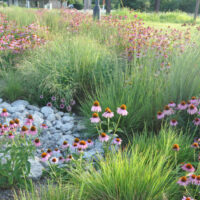 Illinois-Indiana Sea Grant Newsroom – During large rainstorms, many Illinois residents brace themselves for flooding in their basements, streets and neighborhoods. A new online tool, Illinois Groundwork, provides communities and stormwater professionals with resources on green stormwater infrastructure, which provides a way for rain to be absorbed into soil where it lands.
Illinois-Indiana Sea Grant Newsroom – During large rainstorms, many Illinois residents brace themselves for flooding in their basements, streets and neighborhoods. A new online tool, Illinois Groundwork, provides communities and stormwater professionals with resources on green stormwater infrastructure, which provides a way for rain to be absorbed into soil where it lands.
Green stormwater infrastructure offers a way to enhance traditional or “grey” infrastructure using a rain garden or permeable pavement but this approach doesn’t always work as well as it might. Improving access to, and use of, data, research and other resources can help increase the effectiveness of green infrastructure in addressing stormwater management challenges.
“The University of Illinois not only has relevant research and data across many departments, but also real-world examples of successful green infrastructure, along with other extension and education tools, such as the Red Oak Rain Garden,” said C. Eliana Brown, University of Illinois Extension stormwater specialist. “This new tool brings these resources together, providing a robust platform to access green infrastructure knowledge.”
The project is a collaboration of Illinois–Indiana Sea Grant and Illinois Extension. A critical component of Illinois Groundwork is an Illinois-Indiana Sea Grant (IISG)-funded research project that focused on incorporating soils data into green infrastructure design. Soils are the foundation of effective green stormwater infrastructure performance.
“Soil characteristics establish how much and how fast water can move through and absorb into the soil,” explained Margaret Schneemann, IISG water resource economist. “Failing to take soils performance into account means we are not designing green infrastructure as cost-effectively as we could be and may be leaving its benefits on the table.”
Illinois-Indiana Sea Grant is a partnership between NOAA, University of Illinois Extension, and Purdue University Forestry and Natural Resources, bringing science together with communities for solutions that work. Sea Grant is a network of 34 science, education and outreach programs located in every coastal and Great Lakes state, Lake Champlain, Puerto Rico and Guam.
More Resources:
Implementation Examples of Smart Growth Strategies in Indiana, The Education Store, Purdue Extension’s resource center
Conservation Through Community Leadership, The Education Store
Conservation Through Community Leadership, Sustainable Communities Extension Program (SCEP)
Conservation through Community Leadership, Purdue Extension You Tube Channel
Rainscaping Education Program, Purdue Extension
Rainscaping and Rain Gardens, Purdue Extension YouTube Channel
Tipping Point Planner, The Education Store
Tipping Point Planner, Purdue Agriculture YouTube Channel
Enhancing the Value of Public Spaces, The Education Store
Enhancing the Value of Public Spaces: Creating Healthy Communities, The Education Store
Enhancing the Value of Public Spaces Program, Purdue Extension YouTube Channel
One Water Approach to Water Resources Management, The Education Store
Community Development, Purdue Extension
Community Planning Playlist, Purdue Extension-Forestry & Natural Resources (FNR) YouTube Channel
Indiana Creek Watershed Project – Keys to Success, Partnerships and People, Subscribe to Purdue Extension-FNR YouTube Channel
Climate Change and Sustainable Development, The Education Store
Climate Change: Are you preparing for it?, The Education Store
Illinois-Indiana Sea Grant Newsroom: Last May, Illinois-Indiana Sea Grant (IISG) launched its third buoy in southern Lake Michigan—this one based in the busy waters off Navy Pier. This new buoy with its flow of in-the-moment data is helping the National Weather Service (NWS) Chicago develop more accurate forecasts and warnings, especially related to nearshore wave heights and wind speeds.
This third buoy, known affectionately as Chuoy, joins IISG buoys in the nearshore waters of Michigan City, Indiana and Wilmette, Illinois. Together, these three, along with two University of Illinois buoys closer to the Wisconsin border, paint a comprehensive picture of coastal lake conditions in the two states. In addition to meteorologists, the data is used by scientists, boaters, anglers and beach goers.
“Information from these buoys allows recreational water users to make better informed decisions when it comes to safety,” said Ben Szczygiel, IISG buoy specialist. “The data allows people to plan for current conditions and avoid the water when there are increased safety concerns.”
For full article and videos please visit New to Navy Pier waters, Chuoy the Buoy proved a valuable forecasting tool-IISG
About IISG: These are trying times for the environment. Climate change and other concerns such as population growth, aquatic invasive species, contaminated waters, and loss of natural habitat, the southern Lake Michigan region faces many challenges. Illinois-Indiana Sea Grant (IISG), with its unique mandate to bring the latest science to those who can best use the information, serves a critical role in empowering people to solve problems in sustainable ways. The program is funded through National Oceanic and Atmospheric Administration (NOAA), the University of Illinois and Purdue University, but IISG also works in partnerships with key organizations, institutions, and agencies in the region to reach more audiences and multiply opportunities for success. IISG brings together scientists, educators, policy makers, community decision makers, outreach specialists, business leaders, and the general public to work towards a healthy environment and economy.
Resources
Center For Great Lakes Literacy (CGLL), Website
Ask An Expert: Hot and Cold, Video, Purdue Extension – Forestry and Natural Resources YouTube channel
Informing the Development of the Great Lakes Region Decision Support System, The Education Store, Purdue Extension’s resource center
Urban Best Management & Low Impact Development Practices, The Education Store
Improving Water Quality Around Your Farm, The Education Store
New website: Eat Midwest Fish, Got Nature? Blog, Purdue Extension – Forestry and Natural Resources (FNR)
Scientists bring the Great Lakes to students learning from home, Got Nature? Blog
Adaptations for Aquatic Amphibians Activity 2: Water Quality Sneak Peak, Purdue Nature of Teaching
Illinois-Indiana Sea Grant (IISG)
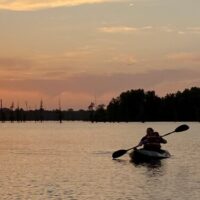 MyDNR, Indiana’s Outdoor Newsletter: Become a Paddlecraft Wildlife Index volunteer and help DNR by documenting the wildlife you observe while on the water from June 1 to July 31. After signing up online, you will be mailed a packet with details on how to participate.
MyDNR, Indiana’s Outdoor Newsletter: Become a Paddlecraft Wildlife Index volunteer and help DNR by documenting the wildlife you observe while on the water from June 1 to July 31. After signing up online, you will be mailed a packet with details on how to participate.
Paddling is a great way to enjoy Indiana’s natural beauty, observe wildlife, and connect with nature. Indiana paddlers have a unique opportunity to observe wildlife while enjoying Indiana’s countless water resources. Indiana DNR would like more information about the wildlife that spend time around Indiana’s waterways. The Indiana Paddlecraft Wildlife Index compiles wildlife observations from people who use canoes, kayaks, or other non-motorized paddlecraft on Indiana’s waterways. Volunteer paddlers can help by completing a paddling trip postcard documenting the wildlife they observed while floating from June 1 to July 31.
Newsletter can be found online May: DNR: Communications: MyDNR Email Newsletter (in.gov)
For more information please visit Paddlecraft Wildlife Index – MyDNR.
Resources:
Yellow Perch Farmed Fish Fact Sheet, The Education Store, Purdue Extension’s resource center
Rainbow Trout Farmed Fish Fact Sheet, The Education Store
American Paddlefish, The Education Store
Aquaculture Family Coloring Book Development, The Education Store
Eat Midwest Fish, Illinois-Indiana Sea Grant online resource hub
Protect Your Waters, U.S. Fish and Wildlife Service & U.S. Coast Guard
What are invasive species and why should I care?, Got Nature? Blog, Purdue Extension – Forestry and Natural Resources
Aquatic Invasive Species in the Great Lakes: The Quagga Mussel, Purdue Extension – Forestry & Natural Resources (FNR) Got Nature? Blog
Aquatic Invaders in the Marketplace, Illinois-Indiana Sea Grant (IISG)
Invasive Species, Playlist, Purdue Extension – FNR YouTube Channel
Nongame and Endangered Wildlife, Indiana Department of Natural Resources
Subscribe to Purdue Extension-FNR YouTube Channel
Indiana Department of Natural Resources, Department of Fish & Wildlife
MyDNR, Indiana’s Outdoor Newsletter: With around 200 different species of fish in Indiana waters, it’s not uncommon that Hoosier anglers might hook a species they’ve never seen before.
For more information and how to identify fish please visit Fishing Species & Identification.
Send a picture with the location information and date of your catch to fishid@dnr.IN.gov, and a biologist will respond to you with an identification. Not only do you receive an identification, DNR biologists benefit by gaining new information on the distribution of some of our less common species.
Resources:
FNR Extension Aquaculture and Aquatic Resources
FNR Extension Publications
Indiana Pond Fish, Species Identification Card Set, Purdue Extension – Forestry and Natural Resources (FNR)
Walleye Farmed Fish Fact Sheet, The Education Store, Purdue Extension’s resource center
Pacific White Shrimp Farmed Fact Sheet, The Education Store
Yellow Perch Farmed Fish Fact Sheet, The Education Store
Tilapia Farmed Fish Fact Sheet, The Education Store
Rainbow Trout Farmed Fish Fact Sheet, The Education Store
American Paddlefish, The Education Store
A Guide to Small-Scale Fish Processing Using Local Kitchen Facilities, The Education Store
Aquaculture Family Coloring Book Development, The Education Store
Eat Midwest Fish, Illinois-Indiana Sea Grant online resource hub
Aquatics & Fisheries Videos, Purdue Extension-Forestry and Natural Resources YouTube Channel Playlist
Indiana Department of Natural Resources, Department of Fish & Wildlife
Recent Posts
- Learn to Process Your Own Deer – Wild Bulletin
Posted: November 11, 2024 in Aquatic/Aquaculture Resources, Forestry, How To, Wildlife - Publication – Handbook on Processing Fish for Small-Scale Fish Farmers
Posted: October 17, 2024 in Aquaculture/Fish, Aquatic/Aquaculture Resources, How To, Publication, Wildlife - Economics and Aquaculture Expert Kwamena Quagrainie is Featured Specialist in ANR Newsletter
Posted: October 15, 2024 in Aquatic/Aquaculture Resources, Great Lakes - Buoys Keep Eye on Great Lake Conditions
Posted: July 11, 2024 in Aquatic/Aquaculture Resources, Great Lakes, How To - IISG Adds New Water Safety Videos
Posted: May 8, 2024 in Aquaculture/Fish, Aquatic/Aquaculture Resources, Community Development, Great Lakes, Wildlife - 2024-25 Fishing Guide now available – Wild Bulletin
Posted: April 4, 2024 in Alert, Aquaculture/Fish, Aquatic/Aquaculture Resources, How To, Ponds, Wildlife - Look Out for Invasive Carp in Your Bait Bucket – Wild Bulletin
Posted: March 31, 2024 in Alert, Aquaculture/Fish, Aquatic/Aquaculture Resources, Invasive Animal Species, Wildlife - Renew Your Indiana Annual Fishing, Hunting, and Trapping License, MyDNR
Posted: March 28, 2024 in Aquaculture/Fish, Aquatic/Aquaculture Resources, How To, Wildlife - Kwamena Quagrainie Receives Fulbright Specialist Award to Ghana – IISG
Posted: March 27, 2024 in Aquaculture/Fish, Aquatic/Aquaculture Resources, Community Development - Report Your Mudpuppy Observations to Indiana DNR – Wild Bulletin
Posted: February 1, 2024 in Alert, Aquaculture/Fish, Aquatic/Aquaculture Resources, How To, Wildlife
Archives
Categories
- Alert
- Aquaculture/Fish
- Aquatic/Aquaculture Resources
- Ask the Expert
- Christmas Trees
- Community Development
- Disease
- Drought
- Forestry
- Forests and Street Trees
- Gardening
- Got Nature for Kids
- Great Lakes
- How To
- Invasive Animal Species
- Invasive Insects
- Invasive Plant Species
- Land Use
- Natural Resource Planning
- Nature of Teaching
- Plants
- Podcasts
- Ponds
- Publication
- Safety
- Spiders
- Timber Marketing
- Uncategorized
- Urban Forestry
- Webinar
- Wildlife
- Wood Products/Manufacturing
- Woodland Management Moment
- Woodlands
